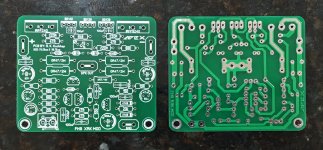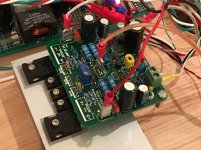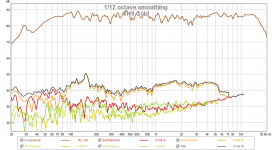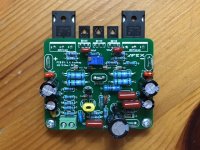FH9 First Sound
This amp is super easy to build, basically same as FX8 but with one more transistor and four drain resistors on the output. It fired up the first time no issues. With matched BC546 input LTP's I am getting 3mV DC offset. I set it for 110mA bias current and it sounds real nice. I have it powering my usual Scan Speak 10F/8424 and Dayton RS225-8 transient perfect FAST speaker. Deep clean tight bass, clear mids and highs. Harmonic distortion spectrum of the speaker is just as good as my Vhex amp - so we know that the amp is not the source of the distortion spectrum. However, when I first turned it on and listening to it cold - it sounded terrible. It needs to warm up and likes to run hot (not too hot as I can touch heat sink indefinitely). This amp is completely built from Aliexpress parts including the IRFP240/9240 hexFETs. This was my test case for hexFETs from China - seems to work well.
Here is the amp fed by a 35v rail 250VA power supply:
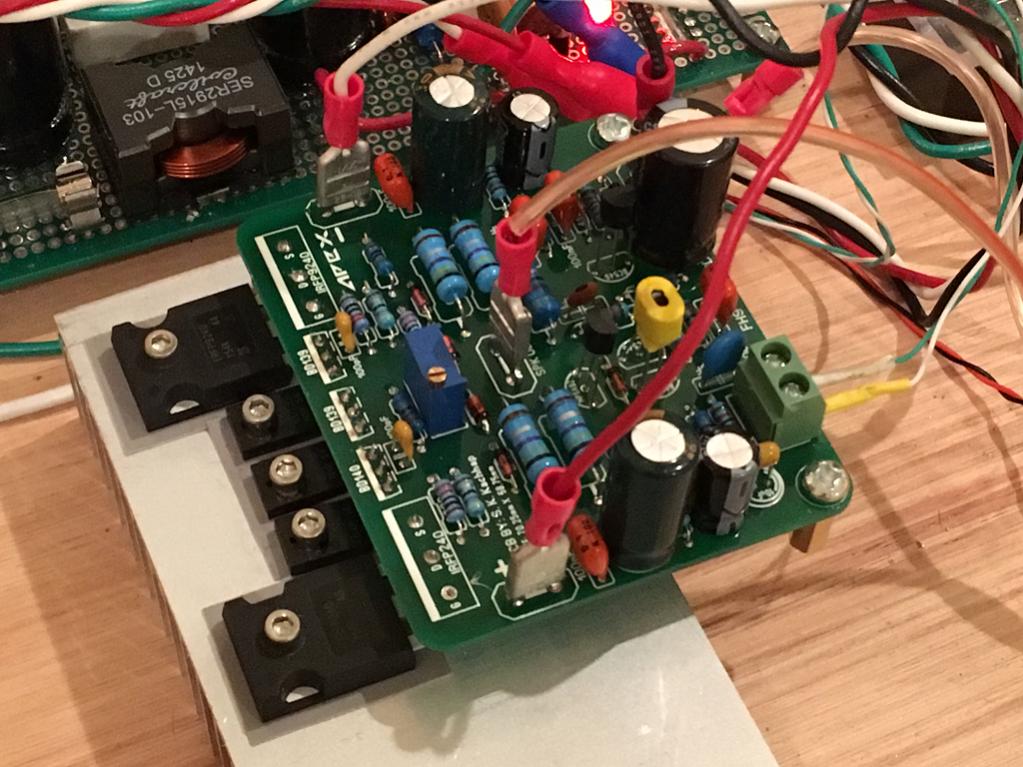
Here is the measured HD spectrum at 2.83v and 0.5m - very similar result to my Vhex reference amp.
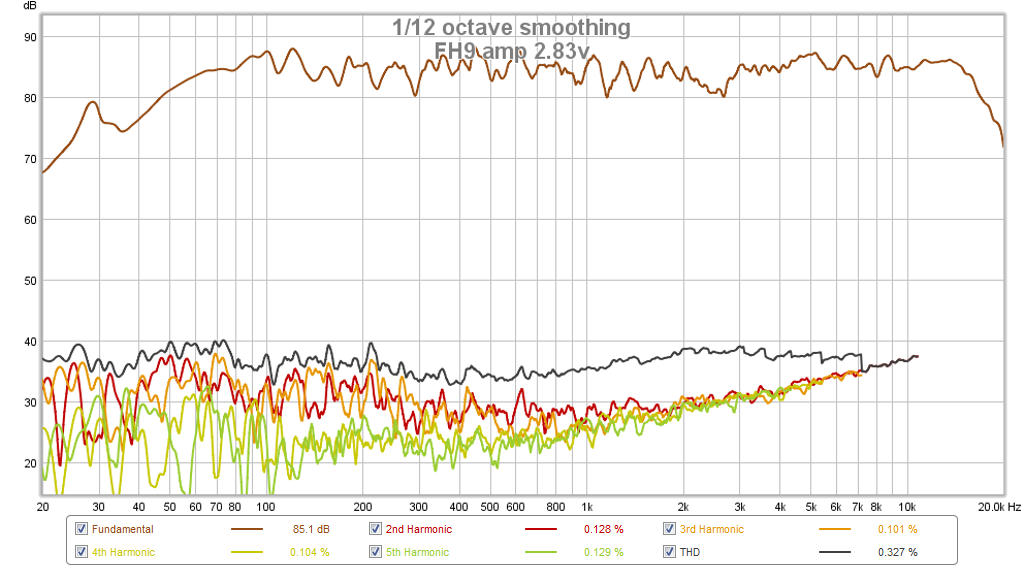
Here is what the HD spectrum looked like when it was still cold - look at all that H3! Good thing I continued to let it warm up.

I recorded a sound clip with the UMIK-1 measurement mic, have a listen and let me know what you think. Change .asc extension to .mp3 to listen.
This amp is super easy to build, basically same as FX8 but with one more transistor and four drain resistors on the output. It fired up the first time no issues. With matched BC546 input LTP's I am getting 3mV DC offset. I set it for 110mA bias current and it sounds real nice. I have it powering my usual Scan Speak 10F/8424 and Dayton RS225-8 transient perfect FAST speaker. Deep clean tight bass, clear mids and highs. Harmonic distortion spectrum of the speaker is just as good as my Vhex amp - so we know that the amp is not the source of the distortion spectrum. However, when I first turned it on and listening to it cold - it sounded terrible. It needs to warm up and likes to run hot (not too hot as I can touch heat sink indefinitely). This amp is completely built from Aliexpress parts including the IRFP240/9240 hexFETs. This was my test case for hexFETs from China - seems to work well.
Here is the amp fed by a 35v rail 250VA power supply:

Here is the measured HD spectrum at 2.83v and 0.5m - very similar result to my Vhex reference amp.

Here is what the HD spectrum looked like when it was still cold - look at all that H3! Good thing I continued to let it warm up.

I recorded a sound clip with the UMIK-1 measurement mic, have a listen and let me know what you think. Change .asc extension to .mp3 to listen.
Attachments
Last edited:
X,
Congrats on another successful build. We need to find out why the sound is distorted in cold condition. Is it due to some cap burning in, or due to bias instability? In case of cap it should not repeat.
Reg
Prasi
Congrats on another successful build. We need to find out why the sound is distorted in cold condition. Is it due to some cap burning in, or due to bias instability? In case of cap it should not repeat.
Reg
Prasi
Last edited:
Thanks Prasi. I suspect it may be a cap burning in because I can't get it to repeat. From cold start this morning I got the same result as the low HD result.
This is the first time I am using the monolithic multilayer 100pF 50v cap at the base of the BD139 and BD140 drivers (those little beige colored caps). I wonder if those needed burn in?
Next one I will use either film caps there or mica discs.
Well at least the problem is gone. 🙂
Want to thank Sonal Kunal for the nice Gerbers.
This is the first time I am using the monolithic multilayer 100pF 50v cap at the base of the BD139 and BD140 drivers (those little beige colored caps). I wonder if those needed burn in?
Next one I will use either film caps there or mica discs.
Well at least the problem is gone. 🙂
Want to thank Sonal Kunal for the nice Gerbers.

Last edited:
parabens xrk971 .... try irfp9140 instead of irfp9240 ... irfp9140 it is more like irfp240
You mean this makes it more symmetric?
Ok I order some 5 for $3.81 can't lose.
Last edited:
I set it for 110mA
110mA is too low for hexfet. They have too high input capacitance compared to latfet. The more you bias them the better the sound. Try 300-400mA if you can manage the heat.
110mA is too low for hexfet. They have too high input capacitance compared to latfet. The more you bias them the better the sound. Try 300-400mA if you can manage the heat.
It depends on the design. The distortion is already low according to the sims. Also on my VHeX+ vzaichenko suggested 80mA and that is even lower - yet there is not distortion. I have tried running at higher currents and it seems hotter only with no benefit. Look at the speaker measurement -55dB is the native HD of the 10F. It's obviously less since it doesn't contribute.
I always start with the output stage then moving backward. What you will get with higher bias on the hexfet are (1) better linearity (2) better high order distortion. Their correlation with sound is very hard to perceive.It depends on the design. The distortion is already low according to the sims.
Thd simulation may only include up to 10 order harmonics (9 is LTspice default). So it doesnt really show the spectrum. If you chase for the lowest thd (up to 10 harmonics), what you will get is very low low order distortion and thd but very ugly high order distortion, not to mention those excluded from calculation.
People may say that frequency above 20k is inaudible and hence irrelevant but i strongly believe in its ugly effect on sound perception in the long run, such as fatigue and boring characteristics.
I can enjoy pass' hexfet amps even tho distortion is high but i have never been able to stay long with class b hexfet.
QUOTE=xrk971;4763028]I have tried running at higher currents and it seems hotter only with no benefit.[/QUOTE]
I like to feel the sound instead of to listen to it because even if i can hearthe difference usually there is trade off and im not sure which one is better. But with feeling the music in the long run i know what i want.
I think the easiest thing to hear with higher bias with high cis fet is the trebles. Listen to certain music with cymbals or triangle or brush on the kettle drum
I always start with the output stage then moving backward. What you will get with higher bias on the hexfet are (1) better linearity (2) better high order distortion. Their correlation with sound is very hard to perceive.It depends on the design. The distortion is already low according to the sims.
Thd simulation may only include up to 10 order harmonics (9 is LTspice default). So it doesnt really show the spectrum. If you chase for the lowest thd (up to 10 harmonics), what you will get is very low low order distortion and thd but very ugly high order distortion, not to mention those excluded from calculation.
People may say that frequency above 20k is inaudible and hence irrelevant but i strongly believe in its ugly effect on sound perception in the long run, such as fatigue and boring characteristics.
I can enjoy pass' hexfet amps even tho distortion is high but i have never been able to stay long with class b hexfet.
QUOTE=xrk971;4763028]I have tried running at higher currents and it seems hotter only with no benefit.[/QUOTE]
I like to feel the sound instead of to listen to it because even if i can hearthe difference usually there is trade off and im not sure which one is better. But with feeling the music in the long run i know what i want.
I think the easiest thing to hear with higher bias with high cis fet is the trebles. Listen to certain music with cymbals or triangle or brush on the kettle drum
Ok - I might give higher bias current a try again. I am going with fan cooling so heat shouldn't be a problem. I will get a stereo setup going to really hear the differences.
Second channel just built. Need to mount on heatsink. I am doubling up on 1 heatsink and fab cooling.
Can this amp be run at 44v rails?
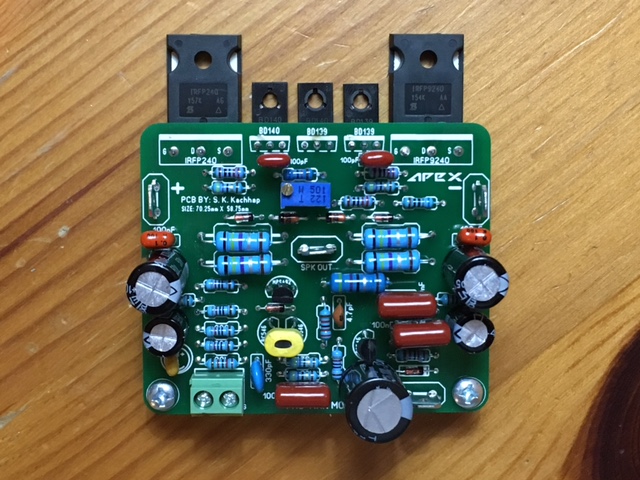
Second channel just built. Need to mount on heatsink. I am doubling up on 1 heatsink and fab cooling.
Can this amp be run at 44v rails?

Attachments
Last edited:
The faster you can do a clean squarewave the sharper the edge transition is - hence faster slew rate. It just means the amp is capable of clean fast transients. We hear to 20khz but what happens above 20khz is indirectly audible in the time domain. For realistic percussion sounds, ideally the speaker should be able to produce above 20khz so that the inverse Fourier transform of the frequency is fast accurate transients.
A speaker that suddenly cuts off at 20k will exhibit ringing in the fine domain. It needs to go above and smoothly roll off.
A speaker that suddenly cuts off at 20k will exhibit ringing in the fine domain. It needs to go above and smoothly roll off.
FH9 in Stereo
Both channels singing gloriously together. I have to say, this amp sounds fantastic! It's one of my new favorites - the bass is really authoritative, tight and deep. Mids and highs are clears and enthralling. No sibillance, no harshness - just smooth. Very nice. 😀
Highly recommended build given the low cost of the hexFET and simplicity of the design. I can give you guys the link for the budget, yet great sounding IRFP240/9240's from Aliexpress if anyone is interested. They appear to be genuine articles given that they sound great, and the finish on the metal heatsink tab and legs is clean and satin - not stamp cut chrome looking.
I made the second one with film caps for 100pF, and used some polyethylene 100nF 400v for the bypass caps as I ran out of the usual orange drop 0.1uF 100v film ones.
Here it is powered from a 35v rail 250va linear supply with a big low ESR (2milliohm) cap bank:
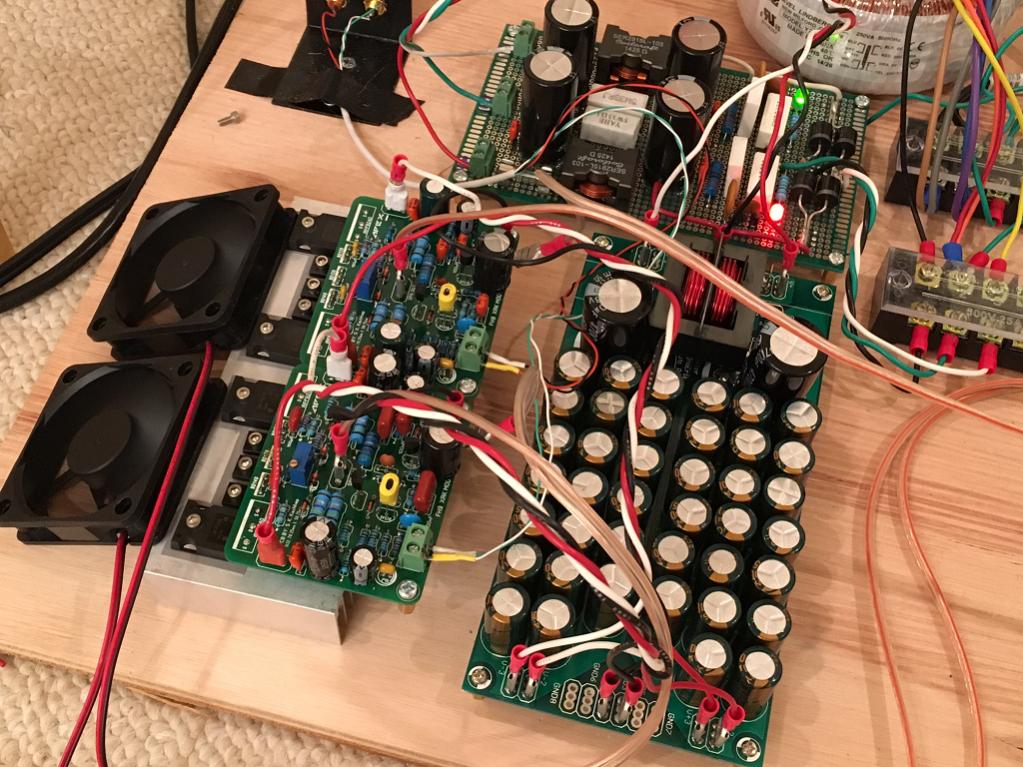
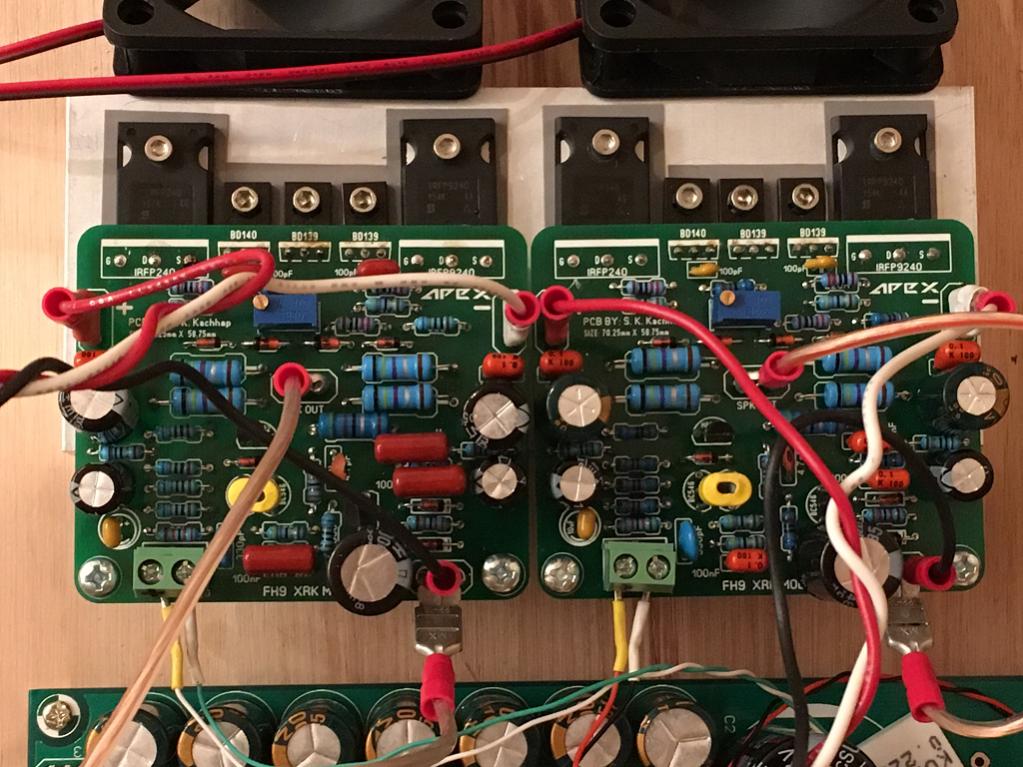
Still running at 110mA bias. Will try the 400mA bias next per Jay's recommendation. However, I don't detect any distortion here.
Also, I am wondering if this can work at 44v rails? Squeeze a little more power out of it and maybe hexFETs sound better at higher voltage?
Both channels singing gloriously together. I have to say, this amp sounds fantastic! It's one of my new favorites - the bass is really authoritative, tight and deep. Mids and highs are clears and enthralling. No sibillance, no harshness - just smooth. Very nice. 😀
Highly recommended build given the low cost of the hexFET and simplicity of the design. I can give you guys the link for the budget, yet great sounding IRFP240/9240's from Aliexpress if anyone is interested. They appear to be genuine articles given that they sound great, and the finish on the metal heatsink tab and legs is clean and satin - not stamp cut chrome looking.
I made the second one with film caps for 100pF, and used some polyethylene 100nF 400v for the bypass caps as I ran out of the usual orange drop 0.1uF 100v film ones.
Here it is powered from a 35v rail 250va linear supply with a big low ESR (2milliohm) cap bank:


Still running at 110mA bias. Will try the 400mA bias next per Jay's recommendation. However, I don't detect any distortion here.
Also, I am wondering if this can work at 44v rails? Squeeze a little more power out of it and maybe hexFETs sound better at higher voltage?
Attachments
Last edited:
Just tested at 400mV bias - no discernible improvement and no changes in measured response of speaker. Just much hotter.
Backing down to 80mA and still sounds fine. Can maybe run passively without a fan now.
Backing down to 80mA and still sounds fine. Can maybe run passively without a fan now.
Nice work.
If you want to help others,just post schematic diagram,pdf pcb and pictures as built in one post.😉
If you want to help others,just post schematic diagram,pdf pcb and pictures as built in one post.😉
Nice work.
If you want to help others,just post schematic diagram,pdf pcb and pictures as built in one post.😉
I did - it's all in the post 1 index of:
http://www.diyaudio.com/forums/solid-state/292226-directory-apex-audio-amplifiers.html
Also, I am wondering if this can work at 44v rails? Squeeze a little more power out of it and maybe hexFETs sound better at higher voltage?
You can't use 44V rails, because you're using BD139/BD140 transistors in VAS/driver stage.
- Home
- Amplifiers
- Solid State
- 100W Ultimate Fidelity Amplifier
